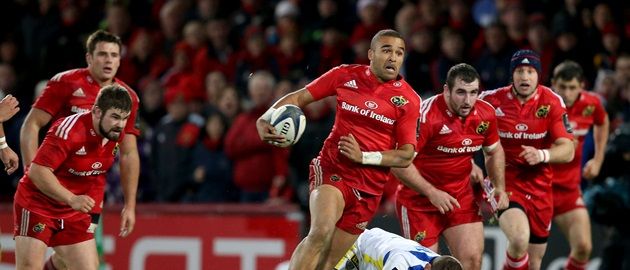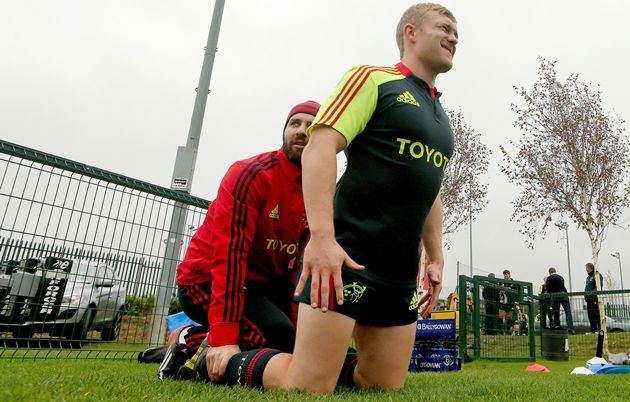‘I am not expecting any more Ricky Hattons.’
Aled Walters has been in the strength and conditioning game for over a decade. He arrived at Munster via rugby postings in Wales, Australia, New Zealand and Wales again.
Such was the growth of this element of the game that Walters was brought on board as Munster’s S&C coach. He is now the province’s Head of Fitness.
Walters – proud Welshman and owner of a hugely impressive beard – talks to us about the ever-changing landscape of professional rugby and managing increasing demands on players.
What do you see as your main fitness tasks at Munster?
I make sure the players are as fast, strong and powerful as possible. Some of that includes building up lean muscle but it is not the be all and end all. We do not work the players every day and we tailor our training plans individually. The goal is to ensure that the players peak at the right time of the season and that they maintain those consistent levels, again, of speed, strength and power. Aidan O’Connell [S&C coach] has been here for 12 years so knows so much about each player, what they need and what will get them through a season in the best possible shape.
Is there a game this season that had the greatest toll on players?
Munster’s Champions Cup game, at Thomond Park, against Clermont. The pace of the game and amount of tackles were both high. There were two very big collisions – at the highest band width [plus 10 G-Force] – reached on the GPS units during that game.
Simon Zebo, at 9.7 metres per second, has told us he is Munster’s fastest player*…
… The province does not reveal individual player statistics but how important are those club records?
There is always a competition element between players but everything we do is to achieve performance improvements.
In the past, we may have considered speed over 40 metres an important metric but we would rarely set that up in training due to the [potential injury] risks involved… We now prioritise accelerations and decelerations over that straight, 40 metre burst.
It would probably surprise you to see who our quickest players are, in those short bursts. There are a few backline players in the top five [for speed] but a couple of forwards. Whereas runners need steady speed over certain distances, rugby players focus on being efficient and effective over those first couple of strides.
Still, many of the players enjoy that competition element – who is the fastest, strongest, who can squat the most. Those metrics and parameters and are now picked up during matches.
Ulster Rugby operate with a contingency for 20% of senior players being injured. Does Munster have a similar figure?
Injuries are inevitable in rugby but we do not have any upper limits or thresholds. It is our job [as S&C and fitness coaches] to prevent as many of the avoidable injuries [strains, pulls] as possible. If guys are getting too many soft tissue injuries, it is possibly down to my poor planning of sessions and workloads.
One of the big changes I have found, since I began [in pro rugby], are the investments and improvements in the treatment of injury. In the past, the least experienced in the [backroom] department looked after injuries. Now injury treatment, and prevention, is prioritised. We have a great medical department here now – including rehab coach PJ Wilson – and have tuned into those needs.
With players increasingly buying into their fitness and conditioning, do certain guys pester you about fad treatments and diets?
There is a real buy-in by the players now. Some players will trawl through the internet and find bits and pieces. It makes my life a lot easier now that we have Dr Catherine Norton in as our performance nutritionist. We can now send a player to her with diet and nutrition queries.
‘Should I eat this because Roger Federer is eating it?’ Catherine is usually good at crushing those hare-brained schemes and getting them back on track.
Is there such thing as down-time any more?
Most players get six weeks off, when the season winds up. Long gone are the days when players completely switch off. Very few will take a complete break from their fitness routines. We do set targets for players to return at for pre-season. We don’t want to be chasing our tails. Most guys are clued in so I don’t think there will be many Ricky Hattons [the Manchester boxer that famously piled on the pounds after bouts].
Are fat clubs common?
Every team I’ve been involved with has had a fat club, or something of a similar name. There is no easy way to tell guys they are fat. However, unless something drastic happens over the summer, this should be the first pre-season we will not have a fat club.
I could not be happier, as it allows us to concentrate on lean mass development, speed, strength, pace and power, rather than worrying about body composition.
*The second fastest player [metres per second] at Munster, according to Zebo, is Keith Earls.









































